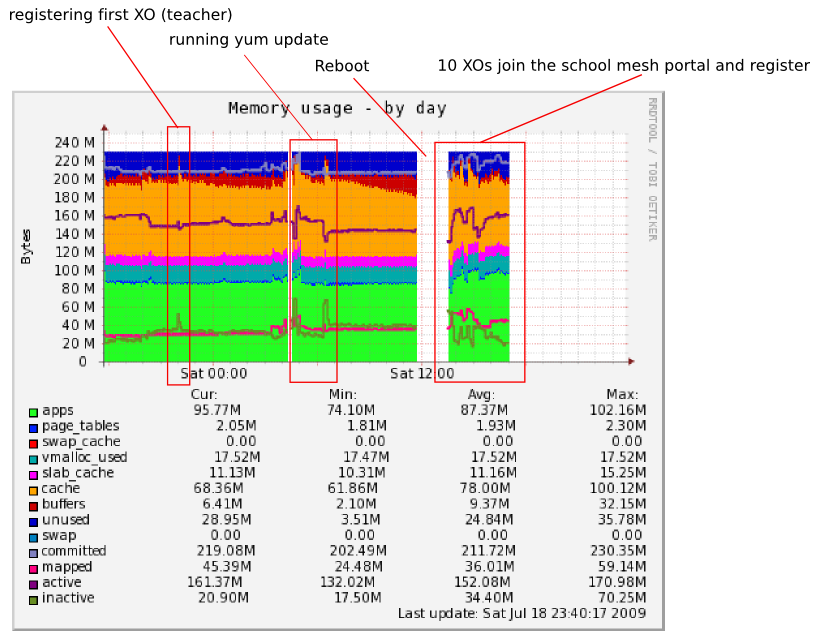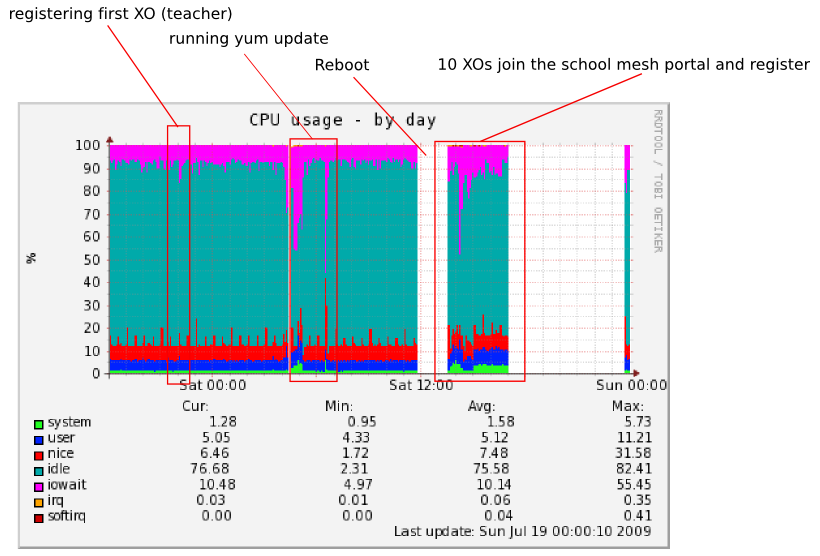XS-on-XO
We have an experimental ext3 image that boots and seems to work correctly as an XS would, on XO hardware.
Grab the image from
http://xs-dev.laptop.org/xs/other/OLPC-School-Server-0.5.2-dev01-i386.img.gz
The sha1 of the uncompressed file is
b34227d6c635d270eceeff7e3107cffa4c08e55c
To install
- Grab a fast SD card, at least 4GB (though smaller cards may work in some cases, see below)
- Uncompress the image with gzip -d
- Identify the mountpoint for the first partition -- usually /dev/mmcblk0p1 or /dev/sdX1
- Using fdisk, make the first partition at least 4GB, type 83 (linux) and bootable
- dd if=OLPC-School-Server-0.5.2-dev01-i386.img of=/dev/<device> bs=1M
Now the SD card should just boot on any unlocked XO.
Matching the fs size to the actual partition on the SD card
If your card or first partition is larger, first dd the image onto the card, and then use resize2fs on it. resize2fs will expand it to fill the partition.
If your card is smaller than 4GB (which sometimes happens with cards advertised as 4GB), shrink the partition with resize2fs before using dd. You can expand it to fill the whole partition with resize2fs.
Completing the installation
- Set a password for the root user.
- Follow the Initial Configuration steps outlined in XS_Installing_Software .
- It's probably a wise idea to avoid using Squid on the XO hardware.
Further work
Help is needed with...
- Testing of the XS functionality
- Getting a vanilla F9 kernel+initrd to boot
- ejabberd and postfix complain during the generation of the ext3 image about not having a hostname. Check whether this creates problems, and what fixes can be applied.
- PostgreSQL ('pgsql-xs' service) does not seem to have landed in good shape.
- External disk setup: scripts to setup an external disk to handle /library and swap. Should be hooked up with the usbmount triggers.
- Load testing and tuning of memory settings in apache and postgres -- how many users can reasonably use eJabberd & Moodle with our limited memory?
- Scripts to auto-configure usb-ethernet adapters as eth0
- Scripts to auto-configure USB "3G" adapters (usually appearing as ppp devices)
- Scripts to switch from mesh portal to hostap
Developer notes
Building the image
- checkout xs-livecd
- wget http://xs-dev.laptop.org/xs/OLPC-School-Server-0.5.2-i386.iso
- sudo ./util/mkext3img OLPC-School-Server-0.5.2-i386.iso imgbuilder/anaconda-f9.ks
Testing notes
Installation
These notes are based on using XS 0.6d [[1]]. The image was uncompressed and written to a 8GB microSD card (class4). The microSD card was plugged into a XO using a SD adapter. Note that the XO had developer keys so that it could boot from the SD card. Also note, that the install was updated from the olpcxs-testing repo using 'yum --enablerepo=olpcxs-testing update'
Performance
Overall performance is acceptable for the 10 XOs we had in the pool, although bulk of the XOs were either routing to the Internet (eth0 via USB-to-Ethernet) or collaborating across XOs via Gabble. They were not using Moodle extensively. Initial Moodle access does tend to be slow. Performance may improve with a class 6 card (we did not have access to a class 6 card). Other points of interest are the point when we ran yum update, and when the XOs register and access the schoolserver link, leading to Moodle. There's also the corresponding CPU usage below.
From an end-user perspective, the XS-on-XO held up throughout the test (about 4 hours) while continuously serving 10 XOs. The users did not complain about any slowdown of the network, collaboration problems, etc. ejabberd did not fail throughout the test.

